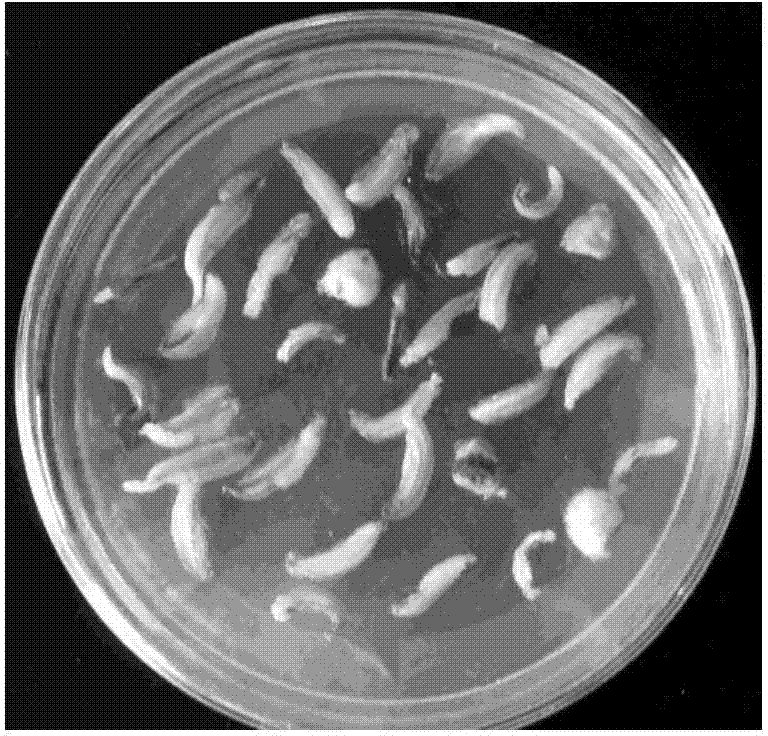A method for inducing eggplant anthers to regenerate haploid plants
A haploid and anther technology, applied in the field of plant biology, can solve the problems of low callus induction rate and differentiation rate, high callus differentiation frequency, and good culture effect, and achieve callus induction rate and differentiation rate High, good callus proliferation and plant propagation effect, high culture efficiency
- Summary
- Abstract
- Description
- Claims
- Application Information
AI Technical Summary
Problems solved by technology
Method used
Image
Examples
Embodiment 1
[0046] A method for inducing eggplant anthers to regenerate haploid plants, the steps of which are: (test material selection, culture medium design and inoculation culture)
[0047] 1. The source and treatment of test materials:
[0048]The test material of the present invention is selected from eggplant flower buds, collected from the greenhouse of the breeding base of Wuhan Vegetable Science Research Institute, Hubei Province, and the variety code is E83002, which is a first-generation Japanese hybrid eggplant variety. From the flowering stage of eggplant, flower buds are taken from healthy plants at 9:00-10:00 am on a sunny day, and the flower buds with normal development, no damage on the surface, and microspores in the single-nucleate marginal stage are selected for anther culture, corresponding to flower buds The external shape is that the corolla is 1mm-2mm lower than the base of the calyx fissure to the corolla is 1mm-2mm higher than the base of the calyx fissure (see ...
Embodiment 2
[0063] Effects of Low Temperature Pretreatment on Induction Rate of Eggplant Anther Callus
[0064] Eggplant has a very long flowering period (from early May to early October). After the collected anthers have been treated at low temperature (4°C-5°C) for different periods of time, they are inoculated in MS+0.5mg / L2, 4-D+1.0mg / L KT+8mg / L VC + 30.0g / L sucrose + 7.5g / L agar on the most suitable medium, and the results of investigation after 45 days of culture under light conditions showed that (see Table 2), the callus induction rate of anthers treated at different times at low temperature was 1 and Induction rate 2 was significantly increased, but there were significant differences between treatments at different times, which was similar to other plant effects, except that the temperature and time of low temperature were different. This study showed that relative treatment 24h induction rate 1 and induction rate 2 both reached the highest. Therefore, 24h low temperature treatm...
Embodiment 3
[0069] Effects of phytohormones on callus differentiation of adventitious buds:
[0070] In plant tissue culture, NAA is a widely used auxin growth regulator, and the most significant physiological function of cytokinin 6-BA and KT is to promote cell division. Mixed use of auxin and cytokinin can regulate callus differentiation.
[0071] In this study, 6 different concentration combinations of 6-BA, KT and NAA were set up. It can be seen from Table 3 that the effect of the combination of cytokinin KT and NAA is significantly better than that of 6-BA, which is similar to the research results of Zou Jian et al. And the combination of 2.0mg / L KT and 0.01mg / L NAA has the best effect.
[0072] Table 3 Effects of hormones on callus differentiation
[0073]
[0074]
PUM
 Login to View More
Login to View More Abstract
Description
Claims
Application Information
 Login to View More
Login to View More - R&D
- Intellectual Property
- Life Sciences
- Materials
- Tech Scout
- Unparalleled Data Quality
- Higher Quality Content
- 60% Fewer Hallucinations
Browse by: Latest US Patents, China's latest patents, Technical Efficacy Thesaurus, Application Domain, Technology Topic, Popular Technical Reports.
© 2025 PatSnap. All rights reserved.Legal|Privacy policy|Modern Slavery Act Transparency Statement|Sitemap|About US| Contact US: help@patsnap.com



